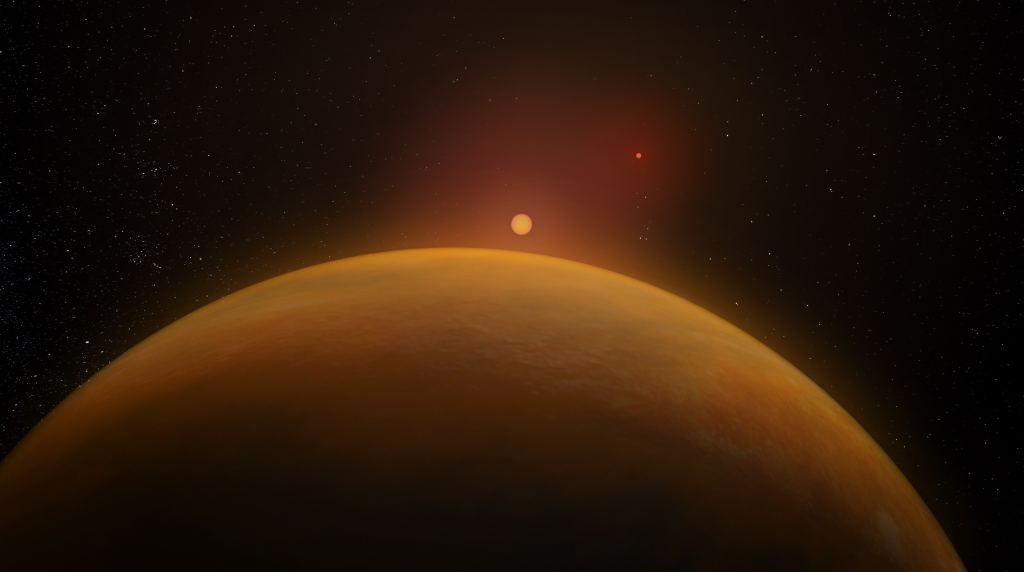To date, 5,084 extrasolar planets have been confirmed in 3,811 planetary systems, with another 8,912 candidates awaiting confirmation. These discoveries have provided astronomers with a detailed sampling of the types of planets that exist in our Universe, ranging from gas giants several times the size of Jupiter to smaller, rocky bodies like Earth. So far, the vast majority of these have been discovered using indirect methods – like the Transit Method (Transit Photometry) and the Radial Velocity Method (Doppler Spectroscopy) – while the remainder has been detected using various other means.
In a recent study, an international team of astronomers used the National Science Foundation’s (NSF) Very Long Baseline Array (VLBA) network to detect a Jupiter-like planet orbiting in a binary system (GJ 896AB) located about 20 light-years from Earth. Using a method known as Astrometry, the team managed to detect this planet by the “wobble” it makes as it orbits the larger of the system’s two stars. Moreover, this method allowed the team to create the first 3-dimensional architecture of a binary system and a planet that orbits one of its stars.
The research team was led by Dr. Salvador Curiel Ramirez, a researcher with the Institute of Astronomy at the National Autonomous University of Mexico (UNAM). He was joined by colleagues from the UNAM and researchers with the Max Planck Institute for Radio Astronomy (MPIFR) and the National Radio Astronomy Observatory (NRAO).
The paper that describes their research, titled “3D Orbital Architecture of a Dwarf Binary System and Its Planetary Companion,” was published on September 1st in The Astronomical Journal. The system under study, GJ 896AB, consists of two red dwarf stars that orbit each other. The larger of the two, the one orbited by the Jupiter-like exoplanet (GJ 896 Ab), is about 44% as massive as our Sun, while the smaller one is about 17% as massive.
They are separated by a distance close to the distance between Neptune and the Sun (~30 AUs) and have an orbital period of 229 years. As Dr. Curiel explained in an NRAO press release, the 3D mapping they performed could not be achieved with other exoplanet discovery methods.
“Since most stars are in binary or multiple systems, being able to understand systems such as this one will help us understand planet formation in general,” he said. In addition, M-type (red dwarf) stars are the most common in the Universe, accounting for about 75% of stars in the Milky Way alone. These low-mass, dimmer stars can remain in their main sequence stage for up to ten trillion years and are notable for supporting smaller rocky planets – such as Proxima b and d and the seven-planet system of TRAPPIST-1.
For their study, Dr. Curiel and his colleagues combined VLBA data obtained between 2006 and 2011 (and new data obtained in 2020) with observations made of the system between 1941 and 2017. The resolution provided by the VLBA’s ten telescopes across the U.
S. produced extremely precise measurements of the stars’ positions over time. They then performed an extensive analysis of the data that revealed the stars’ orbital motions and their common motions through space.
This process, where the position and proper motion of stars are measured, is known as Astrometry. Their detailed assessment of the larger star’s motion showed a slight wobble resulting from a gravitational effect on the star, which revealed the existence of the planet orbiting it. Based on the level of gravitational influence, the team calculated that this planet is a gas giant, roughly twice the mass of Jupiter.
They also determined that it orbits its parent star at a distance slightly less than that of Venus’ from the Sun, has an orbital period of 284 days, and is included roughly 148 degrees from the orbits of the two stars. “This means that the planet moves around the main star in the opposite direction to that of the secondary star around the main star,” said co-author Gisela Ortiz-León, a researcher with the UNAM and the MPIA. “This is the first time that such dynamical structure has been observed in a planet associated with a compact binary system that presumably was formed in the same protoplanetary disk.
” The astrometric technique will be a valuable tool for characterizing more planetary systems, which will benefit from observatories like the planned Next Generation Very Large Array (ngVLA). This massive network will consist of 244 18-meter (59-foot) dishes spread over a distance of 8,860 km (5,505 mi), with an additional short-spacing array of 19 6-meter (20-foot) dishes at the heart of the telescope. The improved sensitivity will allow astronomers to detect smaller rocky planets that orbit more closely to their stars – where “Earth-like” planets are most likely to reside.
Said co-author Joel Sanchez-Bermudez of the UNAM: “Additional detailed studies of this and similar systems can help us gain important insights into how planets are formed in binary systems. There are alternate theories for the formation mechanism, and more data can possibly indicate which is most likely. In particular, current models indicate that such a large planet is very unlikely as a companion to such a small star, so maybe those models need to be adjusted.
” Further Reading: NRAO The post A Planet has Been Found Orbiting Two Stars appeared first on Universe Today. .
From: universetoday
URL: https://www.universetoday.com/157412/a-planet-has-been-found-orbiting-two-stars/



